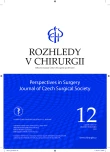Targeted axillary dissection and sentinel lymph node biopsy in breast cancer patients after neoadjuvant chemotherapy – a retrospective study
Authors:
O. Coufal 1,2,3
; O. Zapletal 1; L. Gabrielová 1; P. Fabian 4; M. Schneiderová 5
Authors place of work:
Klinika operační onkologie, Masarykův onkologický ústav, Brno
1; Klinika operační onkologie, Lékařská fakulta Masarykovy univerzity, Brno
2; Regionální centrum aplikované molekulární onkologie, Masarykův onkologický ústav, Brno
3; Oddělení onkologické patologie, Masarykův onkologický ústav, Brno
4; Oddělení radiologie, Masarykův onkologický ústav, Brno
5
Published in the journal:
Rozhl. Chir., 2018, roč. 97, č. 12, s. 551-557.
Category:
Původní práce
Summary
Introduction:
No consensus exists as yet regarding the optimal extent of surgery on the lymph nodes in breast cancer patients after neoadjuvant treatment. In addition to axillary dissection and sentinel lymph node biopsy (SLNB), a new approach called Targeted Axillary Dissection (TAD) was introduced. It requires the marking of metastatic nodes before the neoadjuvant treatment.
Method:
A retrospective observational study on patients with breast cancer and neoadjuvant chemotherapy treated surgically at a single institution in 2017.
Results:
The analysis included 121 cancers in 120 patients. Clinical regression of lymphadenopathy occurred in 29 out of 74 cases. Axillary dissection was performed 34x, SLNB 52x and TAD 35x. In TAD procedures, the marked lymph node was found 30x and was among the sentinel nodes in 19 cases. No case occurred in which the marked node was assessed as negative with a metastasis found in the other nodes. On the contrary, there were 3 cases with negative sentinel nodes whereas the marked node was positive. Out of 74 cases with initially pathologic nodes, 23 patients were spared axillary dissection.
Conclusion:
Clinical assessment of the lymph node status is rather inaccurate. In cases with initially pathologic nodes we recommend marking of the most explicit metastatic node to enable TAD. The marked node is likely to reflect the status of the lymph nodes after neoadjuvant treatment more accurately than common sentinel nodes. A considerable proportion of patients can be spared axillary dissection in this way. However, the long-term oncologic safety of TAD still needs to be verified.
Key words:
breast cancer – neoadjuvant treatment – axillary dissection – sentinel lymph node biopsy – targeted axillary dissection
Zdroje
- Boughey JC, Suman VJ, Mittendorf EA, et al. Alliance for Clinical Trials in Oncology. Sentinel lymph node surgery after neoadjuvant chemotherapy in patients with node-positive breast cancer: the ACOSOG Z1071 (Alliance) clinical trial. JAMA 2013;310:1455−61.
- Kuehn T, Bauerfeind I, Fehm T, et al. Sentinel-lymph-node biopsy in patients with breast cancer before and after neoadjuvant chemotherapy (SENTINA): a prospective, multicenter cohort study. Lancet Oncol 2013;14:609−18.
- Boileau JF, Poirier B, Basik M, et al. Sentinel node biopsy after neoadjuvant chemotherapy in biopsy-proven node-positive breast cancer: the SN FNAC study. J Clin Oncol 2014;33:258−64.
- Caudle AS, Yang WT, Mittendorf EA, et al. Selective surgical localization of axillary lymph nodes containing metastases in patients with breast cancer: a prospective feasibility trial. JAMA Surg 2015;150:137−43.
- Caudle AS, Yang WT, Krishnamurthy S, et al. Improved axillary evaluation following neoadjuvant therapy for patients with node positive breast cancer using selective evaluation of clipped nodes: implementation of targeted axillary dissection. J Clin Oncol 2016;34:1072−8.
- NCCN Clinical Practice Guidelines in Oncology (NCCN Guidelines). Breast Cancer, Version I.2018 – March 20, 2018. NCCN.org. Available from: https://www.nccn.org/professionals/physician_gls/pdf/breast.pdf.
- Coufal O. Možnosti eliminace axilárních disekcí u pacientek s karcinomem prsu pomocí neoadjuvantní léčby. Rozhl Chir 2016;95:381−5.
- Gatěk J, Vrána D, Dudešek B, et al. Můžeme se vyhnout disekci axilárních lymfatických uzlin? Rozhl Chir 2017;96:318−23.
- Dostálek L, Šašková P. Možnosti snížení radikality operací v axile a značení axilárních lymfatických uzlin v rámci terapie karcinomu prsu. Klin Onkol 2017;30:420−5.
- Chevallier B, Roche H, Olivier JP, et al. Inflammatory breast cancer. Pilot study of intensive induction chemotherapy (FEC-HD) results in a high histologic response rate. Am J Clin Oncol 1993;16:223−8.
- Sobin LH, Gospodarowicz MK, Wittekind Ch, eds. TNM classification of malignant tumours (7th ed.). Chichester, West Sussex, UK, Wiley-Blackwell 2010.
- Donker M, Straver ME, Wesseling J, et al. Marking axillary lymph nodes with radioactive iodine seeds for axillary staging after neoadjuvant systemic treatment in breast cancer patients: the MARI procedure. Ann Surg 2015;261:378−82.
- Choy N, Lipson J, Porter C, et al. Initial results with preoperative tattooing of biopsied axillary lymph nodes and correlation to sentinel lymph nodes in breast cancer patients. Ann Surg Oncol 2015;22:377−82.
- Harvey JR, Lim Y, Murphy J, et al. Safety and feasibility of breast lesion localization using magnetic seeds (Magseed): a multi-centre, open-label cohort study. Breast Cancer Res Treat 2018;169:531−6.
- Rüland AM, Hagemann F, Reinisch M, et al. Using a new marker clip system in breast cancer: Tumark Vision® Clip - feasibility testing in everyday clinical practice. Breast Care (Basel) 2018;13:116−20.
- Curigliano G, Burstein HJ, Winer P, et al. De-escalating and escalating treatments for early-stage breast cancer: the St. Gallen International Expert Consensus Conference on the Primary Therapy of Early Breast Cancer 2017. Ann Oncol 2017;28:1700−12.
- Chapman CH, Jagsi R. Postmastectomy radiotherapy after neoadjuvant chemotherapy: A review of the evidence. Oncology (Williston Park) 2015;29:657−66.
Štítky
Chirurgie všeobecná Ortopedie Urgentní medicínaČlánek vyšel v časopise
Rozhledy v chirurgii

2018 Číslo 12
- Metamizol jako analgetikum první volby: kdy, pro koho, jak a proč?
- Specifika v komunikaci s pacienty s ránou – laická doporučení
- MUDr. Lenka Klimešová: Multioborová vizita může být klíčem k efektivnější perioperační léčbě chronické bolesti
Nejčtenější v tomto čísle
- Současné léčebné postupy při střelných poraněních v mírových podmínkách
- Infekčné komplikácie súvisiace s operačnou liečbou degeneratívneho ochorenia driekovej chrbtice
- Cílená axilární disekce a sentinelová biopsie u pacientek s karcinomem prsu po neoadjuvantní chemoterapii – retrospektivní studie
- Crohnova choroba apendixu – kazuistika
